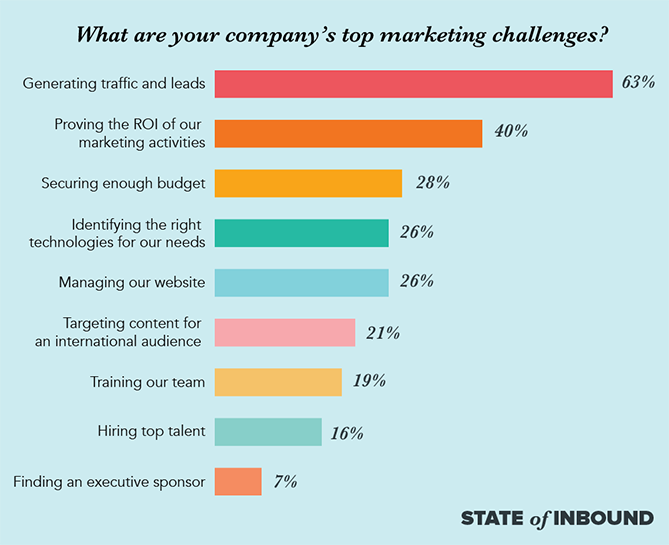
Every internet marketer faces different challenges. Although we typically share similar goals, some teams are stuck on hiring top talent, while others are having trouble finding the right technology for their needs.
Whatever the case may be, there’s always at least one area that you can stand to improve. In other words, there’s always room to optimize the various components of your strategy and turn your marketing into an even more effective revenue generator.
Curious about what kinds of obstacles other internet marketers are up against?
We polled thousands of internet marketers on the challenges they face, as well as the tactics they’ve used to meet those challenges head-on. Here are some of the most common challenges marketers reported struggling with … and their solutions.
The Most Common Marketing Problems We Face, According to the 2017 State of Inbound Report
According to our report, generating traffic and leads and proving ROI are the leading challenges internet marketers face. Here’s a look at this year’s data:

Image Credit: The 2017 State of Inbound Report
Let’s go through each of these top challenges and how internet marketers can address them.
1) Generating Traffic and Leads
Why It’s a Challenge
Generating enough traffic and leads was the top marketing challenge, according to the 2017 State of Inbound report. We started asking this question with this answer as a new option last year — and we’re glad we did.
Clearly, internet marketers are struggling with producing enough demand for their content. And as the years progress and competition stiffens, this will only become truer. With so many options of platforms for marketers to publish their content and even more ways to promote it, it’s hard to know where to focus your efforts.
What Can You Do?
When it comes to creating content that produces enough traffic and leads, internet marketers should ask themselves two questions: Are you truly creating high-quality content — the type of content people would pay for? And, do you know the type of content your audience actually wants?
For example, HubSpot Research has found that 43% of consumers want to see more video from internet marketers in the future, while only 29% want to see more blog posts. To learn more about how the way people are reading and interacting with content is changing, check out this HubSpot Research report.
Once you know you’re creating the type of content your audience wants, the focus shifts to promoting it in a way that makes your audience take notice. More than ever before, people are being flooded with content. Consumers don’t have to use a search engine to find answers. Instead, articles fill their news feed or buzz in their pocket via mobile notification.
Needless to say, the content promotion playbook is not the same as it was five years ago. To make sure your traffic and lead numbers continue to rise, check out this comprehensive guide to content promotion.
2) Providing the ROI of Your Marketing Activities
Why It’s a Challenge
Measuring the ROI (return on investment) of your marketing activities has remained a top marketing challenge year-over-year. But, it also continues to be a vital way for internet marketers to understand the effectiveness of each particular marketing campaign, piece of content, etc.
Plus, proving ROI often goes hand-in-hand with making an argument to increase budget: No ROI tracking, no demonstrable ROI. No ROI, no budget.
But tracking the ROI of every single marketing activity isn’t always easy, especially if you don’t have two-way communication between your marketing activities and sales reports.
What Can You Do?
When it comes to providing ROI, there’s a strong case to be made for dedicating time and resources to establishing links between marketing activities and sales results. This means using both marketing software (like HubSpot) and a CRM solution (like HubSpot’s free CRM), and then tying them together to close the loop between your marketing and sales efforts with a service-level agreement (SLA). That way, you can directly see how many leads and customers are generated through your marketing activities.
We’ve found there’s no better combination than having an SLA and doing inbound marketing. According to this year’s report, inbound organizations with SLAs are 3X more likely to rate their marketing strategy as effective compared to outbound organizations with misaligned marketing and sales teams.
(Use this ROI calculator to simulate the potential ROI you could realize by conducting inbound marketing.)
3) Securing Enough Budget
Why It’s a Challenge
Securing more budget is a pressing challenge for marketing globally. And often, getting more budget is easier said than done — especially for smaller organizations that aren’t working with sizable nor flexible marketing spend.
But the key to securing more money for your team might not be that complex. Here’s what you can do.
What Can You Do?
The key to unlocking budget lies in being able to prove the ROI of your marketing efforts. According to our report, organizations that can calculate ROI are more likely to receive higher budgets.
Again, success with inbound marketing also plays a large role in driving higher budgets. Effective strategies obviously produce results, and our data shows those who feel confident in their marketing strategy are more than 2X as likely to get higher budgets for their marketing teams. But remember, inbound marketing is a long game. If you get off to a slow start, you shouldn’t back off — in fact, you might consider doubling down.
4) Managing Your Website
Why It’s a Challenge
Managing a website was the fourth biggest challenge for marketers in 2017. And chances are, your website’s performance is high on your list of priorities. It’s an asset that works around the clock to draw in visitors, convert them, and help you hit your goals, after all.
Issues with website management include a variety of different factors, from writing and optimizing the content to designing beautiful webpages. Here are a few things internet marketers can do to deal with this challenge.
What Can You Do?
First, read this report to see how your website stacks up against over 1 million other websites. It also includes a deep analysis on the four most critical elements of website performance and design, from average load time and website securityww to mobile friendliness and SEO.
If your primary challenge with managing a website has to do with the skills and resources you have available, you aren’t alone. This is especially true for small companies who don’t have all the talent in-house required to cover content, optimization, design, and back-end website management.
One solution? Hire freelancers and agency partners. To find freelancers, we recommend:
- Tapping into your personal and professional network by posting on LinkedIn, Facebook, and other social networks with a description of what you’re looking for.
- Browsing freelance writers and designers based on their portfolios and areas of interest. For writers, check out Zerys and Contently. For designers, check out Behance & Elance.
- Browsing HubSpot’s Services Marketplace, which lists a wide variety of designers from partner companies and agencies we’ve deemed credible.
Overall, you can make website management easier on your team by hosting your website on a platform that integrates all your marketing channels like HubSpot’s COS.
Finally, for the projects you want to keep in-house, here is a list of ebooks and guides that might be helpful to your team:
- Run a Website Grader report
- Ebook: Website Redesign Guide
- Ebook: 50 Brilliant Homepage Design Examples
- Ebook: How to Design and Optimize Landing Pages
- Ebook: How to Increase Your Website SEO Traffic in 30 Days
- Ebook: The Ultimate Workbook for Redesigning Your Website
- Ebook: The Marketer’s Guide to Mobile
Article Source: https://blog.hubspot.com/blog/tabid/6307/bid/33820/5-major-challenges-marketers-face-and-how-to-solve-them.aspx
On – 26 May, 2017 By Lindsay Kolowich


